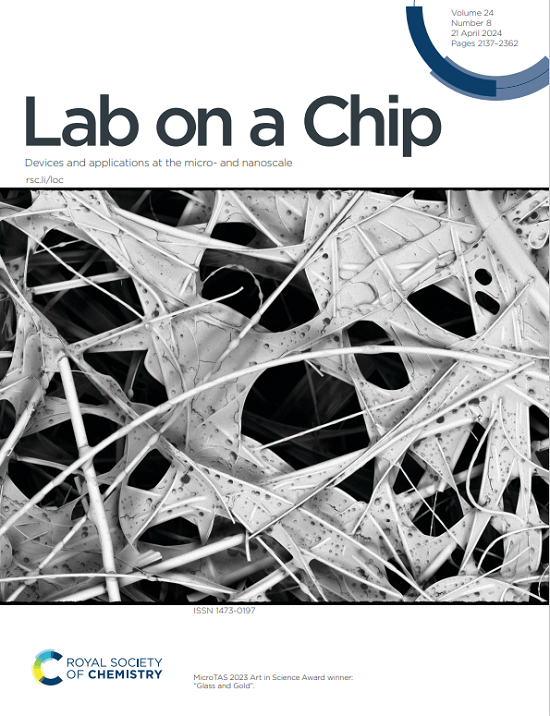CTEPH肺动脉狭窄和内皮功能障碍的三维建模
IF 5.4
2区 工程技术
Q1 BIOCHEMICAL RESEARCH METHODS
引用次数: 0
摘要
慢性血栓栓塞性肺动脉高压(CTEPH)起源于肺动脉的进行性血栓性闭塞,包括未解决的血栓和小血管动脉病变引起的血管阻塞。这会扰乱血流,增加肺压力,改变血管形状,导致内皮功能障碍。然而,其机制尚不清楚。为了研究这些相互作用,我们利用CTEPH和急性肺栓塞(APE)患者的CTPAs,在硅流模拟、3D打印和软lithography中开发了30-80%狭窄的肺动脉微流控3D模型。与标准的圆形通道不同,我们设计了由盖盖包围的半圆形通道,计算模型证实其非常接近真实的船舶流动动力学。在30-80%狭窄通道中培养的人肺动脉内皮细胞(HPAECs)表现出促炎、促血栓和促血管生成基因的表达增加,其反应因狭窄严重程度和位置而异。狭窄后扩张区(60-80%狭窄)的细胞由于血流紊乱而失去对齐和连接完整性。80%狭窄通道中hpaec的转录谱与CTEPH肺内膜切除术标本非常相似。血小板粘附依赖于血管性血液病因子(VWF),随狭窄严重程度和血流速率而变化。低灌注率增加狭窄区域的粘连,而高血流率促进狭窄后的粘连。我们基于患者数据的狭窄模型为研究血管几何形状对血流、内皮反应和血小板聚集的影响提供了一个强大的平台,促进了CTEPH、肺栓塞和其他与血管闭塞相关疾病的研究。本文章由计算机程序翻译,如有差异,请以英文原文为准。
3D Modelling of Pulmonary Arterial Stenosis and Endothelial Dysfunction in CTEPH
Chronic thromboembolic pulmonary hypertension (CTEPH) arises from progressive thrombotic occlusion of pulmonary arteries, involving vessel blockage by unresolved thrombi and small vessel arteriopathy. This disrupts blood flow, increases lung pressure, and alters vessel geometry, contributing to endothelial dysfunction. However, the mechanisms remain unclear. To study these interactions, we developed microfluidic 3D models of pulmonary arteries with 30–80% stenosis using CTPAs from CTEPH and acute pulmonary embolism (APE) patients, in silico flow simulations, 3D printing, and soft lithography. Unlike standard circular channels, we designed semi-circular channels enclosed by a coverslip, which computational modelling confirmed closely mimics real vessel flow dynamics. Human pulmonary artery endothelial cells (HPAECs) cultured in 30–80% stenosis channels exhibited increased expression of pro-inflammatory, pro-thrombotic, and pro-angiogenic genes, with responses varying by stenosis severity and location. Cells in post-stenotic dilatation regions (60–80% stenosis) lost alignment and junctional integrity due to disturbed flow. The transcriptional profile of HPAECs from 80% stenosis channels closely resembled that of CTEPH pulmonary endarterectomy specimens. Platelet adhesion, dependent on von Willebrand factor (VWF), varied with stenosis severity and flow rate. Low perfusion rates increased adhesion in stenotic regions, while higher flow rates promoted adhesion post-stenosis. Our patient data-based stenosis models provide a robust platform for studying the effects of vascular geometry on blood flow, endothelial responses, and platelet aggregation, advancing research on CTEPH, pulmonary embolism, and other diseases associated with vascular occlusion.
求助全文
通过发布文献求助,成功后即可免费获取论文全文。
去求助
来源期刊

Lab on a Chip
工程技术-化学综合
CiteScore
11.10
自引率
8.20%
发文量
434
审稿时长
2.6 months
期刊介绍:
Lab on a Chip is the premiere journal that publishes cutting-edge research in the field of miniaturization. By their very nature, microfluidic/nanofluidic/miniaturized systems are at the intersection of disciplines, spanning fundamental research to high-end application, which is reflected by the broad readership of the journal. Lab on a Chip publishes two types of papers on original research: full-length research papers and communications. Papers should demonstrate innovations, which can come from technical advancements or applications addressing pressing needs in globally important areas. The journal also publishes Comments, Reviews, and Perspectives.
 求助内容:
求助内容: 应助结果提醒方式:
应助结果提醒方式:


